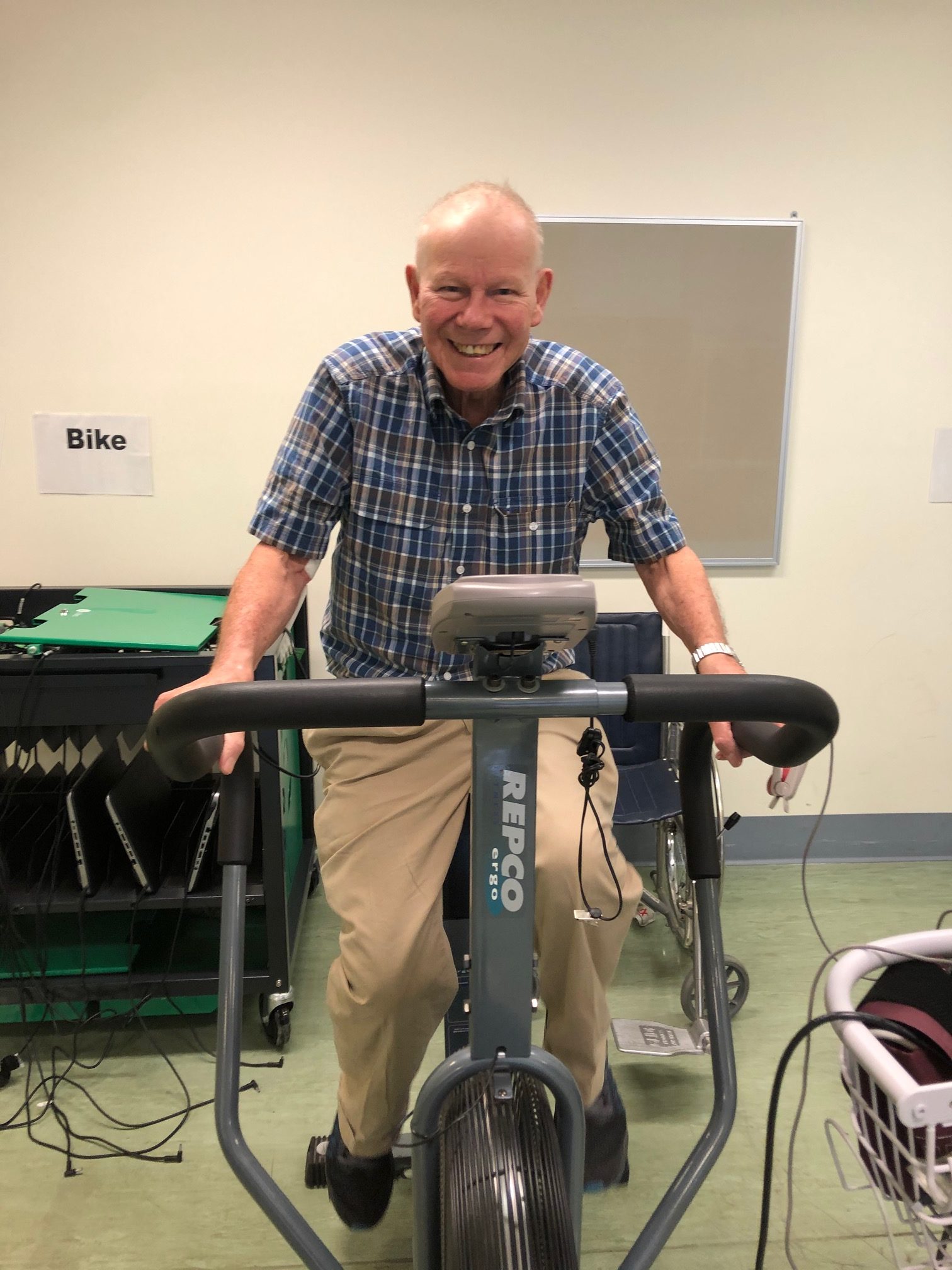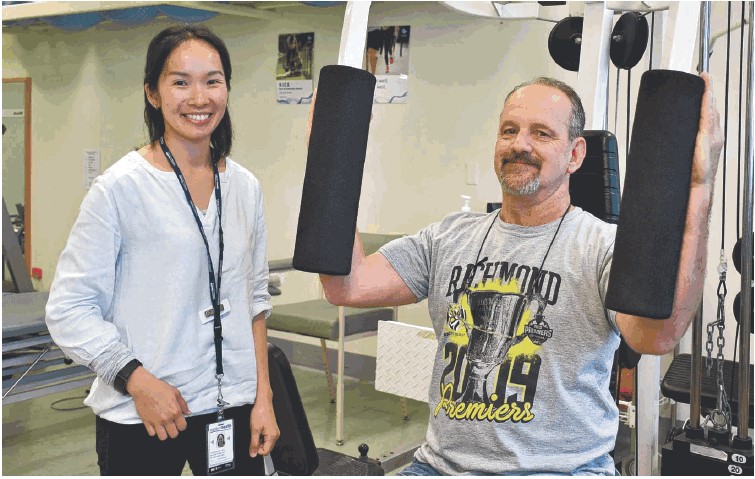History:
Keith is a 67 year old male presenting to you with a diagnosis of Multiple Myeloma who has just been discharged from the acute ward following a Autologous Stem Cell Transplant he received 1 month ago.
He lives at home with his wife and son and is semi-retired, where he works from home part time for himself.
Keith had a challenging admission and became extremely unwell following his stem cell transplant. At one point during his acute admission he required a Nasogatric Tube and supplemental oxygen.
He is now at home and mobilising independently with nil aids, however he reports still feeling very weak.

PMHx:
- Osteoarthritis
- Known lytic lesions at T1 and 2
- Hypertension
- GORD
- Gout
Assessment:
- 6 Minute Walk Test: 340m, nil aid, nil rests, lowest SpO2 98%, BORG RPE Pre 2, Post: 7
- 5 Times Sit to Stand: 20.5secs
- Bicep Curl 10 Repetition Max: 3kg both arms
- Timed up and Go Test: 25.5 secs
Questions:
- What other information do you require of Keith’s situation?
- What other members of the multidisciplinary team would you need to involve?
- Develop a potential exercise program for Keith over the next four weeks. How often would you want him to participate? Will you provide him with any home based instructions?
- What would you monitor Keith for during and after his session?
- What other information do you require of Keith’s situation?
- Is he on any ongoing treatment or have any upcoming treatment plans?
- Pre-morbid mobility and exercise history
- Does he have any associated pain with his known T1-2 Lytic Lesions – what are their size and type
- What other members of the multidisciplinary team may you need to involve?
- Dietitian – likely significant weight loss during acute admission including use of NGT
- Psychologist – possible significant trauma associated with period of being significantly unwell and long hospital admission
- Occupational Therapist for the management of fatigue
- Develop a potential exercise program for Keith over the next four weeks. How often would you want him to participate? Will you provide him with any home based instructions?
- Aim towards 3 x weekly aerobic exercise of 30 mins and 2 x sessions of resistance training – at moderate level of exertion to target Cancer Related Fatigue
- Slowly build towards the goal of 150 mins of exercise per week
- Give him “Being Active When You Have Cancer” info sheet for basic ideas on how to start being more active now that he is home
- What would you monitor Keith for during and after his session?
- During session fatigue and post session fatigue
- HR/SpO2/BP/BORG RPE scale for exertion
- Back pain associated with lytic lesions and adjust exercises accordingly
- Taking regular rest breaks
“I can now stand long enough to cook a meal. Yesterday, my son and I were cleaning out the gutters, and that is something I couldn’t have dreamt of when I started this program.” – Keith
Keith regained much of his energy and was able to join a community health service for ongoing exercise services.
He returned to walking significant distances for exercise and is back on a full diet.

History:
Kelly is a 40 year old female with newly diagnosed, Stage 3 self detected L) breast cancer.
She received a L) mastectomy and axilliary node clearance 3 weeks ago and is now starting Anthracycline chemotherapy.
Kelly lives with her husband and two primary school aged children. She works full time as a police officer and is currently on sick leave. She is usually fit and well but did not participate in formal exercise prior to her diagnosis and currently is walking the dog for exercise.
Her job requires her to pass a fitness test to return to full duties.
Her goals are to have the energy to care for her children and to return to her previous fitness level so she can return to work.
PMHx:
- Left shoulder reconstruction
Assessment:
- 6 Minute Walk Test: 571m, lowest SpO2 100%, BORG: 4
- 5 Times Sit to Stand: 6.65 sec
- Bicep curl 10 Repetition Max: 4kg both arms
- Timed up and Go Test: 9.5 secs
Questions:
- What side effects would you expect from the treatments Kelly is receiving and how would that affect your exercise prescription?
- What education would you provide?
- What type, level and duration of aerobic exercise would you prescribe at a baseline for Kelly?
- What resistance (strength) exercises would you prescribe for Kelly? Draft a 4 week progression of resistance training for Kelly with respect to her goals.
- What side effects would you expect from the treatments Kelly is receiving and how would that affect your exercise prescription?
- Common side effects of chemotherapy: fatigue, loss of appetite, peripheral neuropathy, mucositis, nausea, vomiting, diarrhoea
- Potential post operative shoulder range of motion restriction and pain, lymphoedema
- Begin program with lower repetitions to encourage rests between sets to manage fatigue
- Be conscious of balance exercise programs as Kelly may be at a higher falls risk due to lower limb peripheral neuropathy
- With respect to recent mastectomy – lower starting prescription of UL weights/exercises until confident that pain and wound healing are not being disrupted by exercises
- What education would you provide?
- Importance of ongoing lymphoedema management and monitoring
- Benefits of exercise particularly in the breast cancer population
- Discuss the intensity and frequency of exercise required to achieve such benefits – give patient “Moving Through Cancer” info sheet
- What type, level and duration of aerobic exercise would you prescribe at a baseline for Kelly?
- Considering Kelly’s age, minimal co-morbidities and 6MWT score – our goal is to work Kelly at Moderate – Vigorous intensity of Aerobic exercise (Modified BORG 4-6)
- On a treadmill a starting level of 5.5-6 km/hr with 1-2 level of incline would be appropriate for 10 minutes
- What resistance (strength) exercises would you prescribe for Kelly? Draft a 4 week progression of resistance training for Kelly with respect to her goals.
- Consider the agility, speed and power components required for Kelly’s job alongside endurance for your prescription of resistance exercises
Kelly participated well throughout her exercise program and we were able to add in more challenging core based exercises and plyometric activities.
She is now back at work as a police officer and is regularly completing Pilates which is her preferred form of exercise.
Note: Case studies have been adjusted for educational purposes with the consent of the participants.

